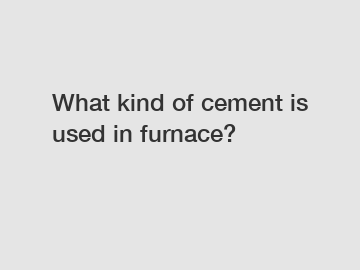Jan. 19, 2024
Minerals
What Kind of Cement is Used in Furnace?
When it comes to the construction of furnaces, the type of cement used plays a crucial role in ensuring its durability and performance. Furnaces operate under extremely high temperatures, and therefore, the cement used must be able to withstand these conditions without deteriorating or losing its strength. In this article, we will explore the different types of cement used in furnaces and the characteristics that make them suitable for such demanding environments.
Refractory Cement:

One of the most commonly used types of cement in furnaces is refractory cement. Refractory cement is specifically designed to withstand high temperatures and harsh conditions. It is made from a blend of materials that can endure exposure to heat, such as alumina, silica, and calcium aluminate. The high alumina content in refractory cement gives it excellent heat resistance, allowing it to retain its strength even at temperatures exceeding 3000°F (1650°C). This makes it ideal for lining the interior of furnaces, where it protects the structural components from the extreme heat.
Insulating Cement:
Insulating cement is another type of cement used in furnaces, particularly for insulating purposes. Its primary function is to reduce heat loss, preventing the furnace from losing heat to its surroundings. Insulating cement is typically composed of lightweight aggregates, such as vermiculite or perlite, mixed with a binder material. The lightweight nature of the aggregates helps to minimize the transfer of heat, resulting in better energy efficiency and lower operating costs. This type of cement is often used in the walls and roofs of furnaces, providing thermal insulation and contributing to the overall heat retention of the system.
Castable Cement:
Castable cement, also known as castable refractory, is a versatile type of cement that can be shaped and molded to suit the specific requirements of a furnace. It is made by combining a fine grain refractory material with a binder, such as alumina cement or calcium aluminate cement. Castable cement offers excellent thermal shock resistance and high mechanical strength, making it suitable for applications that are subject to abrupt temperature changes or mechanical stress. Its ability to conform to complex shapes allows for the creation of custom linings for different parts of the furnace, ensuring proper insulation and protection against extreme temperatures.
Safety Considerations:
When using cement in furnaces, it is essential to consider safety measures to prevent potential hazards. Cement can release harmful substances, such as silica dust, during mixing and application. Therefore, workers must wear appropriate personal protective equipment, including masks and gloves, to minimize exposure. Additionally, proper ventilation systems should be in place to remove any hazardous fumes or dust particles from the working area. Regular maintenance and inspection of the furnace and its cement lining are also necessary to ensure the safety and reliability of the system.
Conclusion:
Selecting the appropriate cement for furnaces is crucial to ensure their efficient and safe operation. Refractory cement, insulating cement, and castable cement are three commonly used types of cement in furnaces, each with its unique properties and applications. By understanding the characteristics of these cements, one can make the right choice for a specific furnace's requirements. However, it is crucial to prioritize safety throughout the construction and maintenance processes to mitigate any potential risks. If you have any further inquiries or need assistance, please do not hesitate to contact us.
Contact us for any further inquiries or assistance.
For more information, please visit industrial furnaces refractory bricks, refractory mortar, Fireclay Brick Recipe.
If you are interested in sending in a Guest Blogger Submission,welcome to write for us!
All Comments ( 0 )